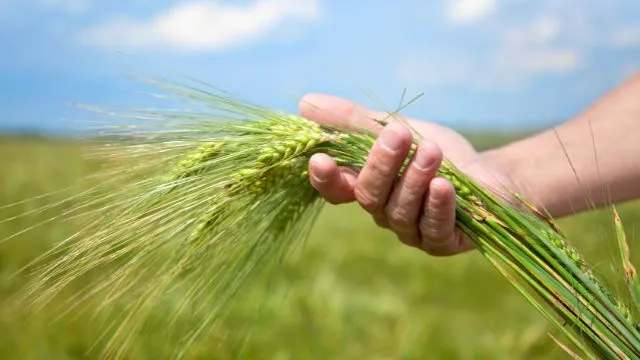Steaming hot chapatis in the North or mouth-watering rava dosas in the South, there’s no denying that wheat is the superstar of many Indian meals. And it doesn’t stop at the dinner table, it’s the backbone of our country’s economy and plays a key role in keeping us fed and happy. In 2023, India yet again secured its spot as the world’s second-largest wheat producer, and that’s no small feat. This incredible accomplishment is the fruit of hard work from numerous states across our country, each making a hefty contribution to our national wheat output.
Therefore today we’re taking a whistle-stop tour of the top ten most wheat-producing states in India in 2023. We’re diving deep into the secrets of their success, giving you a 360-degree view of wheat cultivation in the beating heart of India. So, without further ado, let’s get this show on the road!
List of Top Wheat Producing States in India

1. Uttar Pradesh
Uttar Pradesh (UP) is this amazing state sitting pretty along the mighty Ganges river, swaying fields of wheat stretching as far as the eye can see. Yep, this is the biggest wheat producer in all of India, a veritable bread basket that churned out a whopping 35.9 million tons of the stuff last fiscal year. That’s right, UP has got this wheat game on lock, what with its sprawling cultivation area of 96 lakh hectares. This powerhouse state cranks out a hefty 35% of India’s total wheat production. It’s all in the soil, friend. UP’s land is bursting with minerals and fertility, making it a prime spot for growing wheat. But it’s not just the soil, UP also got top-notch irrigation facilities and is blessed with abundant water resources, the Ganges being the prime one. All this put together? That results in wheat production that is through the roof.
2. Madhya Pradesh
Nestled in the heart of India, Madhya Pradesh is turning heads as a major player in the wheat production scene. Rising from fourth place, it claimed the silver medal as the second-largest wheat producer in the country. Areas like Gwalior, Sagar, Indore, and Ujjain are pumping out wheat like there’s no tomorrow. The wheat machine that is Madhya Pradesh shows no signs of stopping, with a hefty 34.67 million metric tons adding up to roughly 9% of India’s total wheat production. With such a colossal output, this state isn’t just meeting domestic demand, it’s also stoking the fires of international trade. And with its fertile lands and dedicated farmers, Madhya Pradesh is a force to be reckoned with in the wheat world.
3. Punjab
Next, let’s talk about Punjab, India’s bread and butter when it comes to agriculture. This region is all about wheat, growing it in fertile soil and watering it with the plentiful bounty from the region’s five rivers. Although it had to pass the second-place wheat crown to Madhya Pradesh recently, it still stands tall and proud, producing a whopping 16.6 million metric tons of wheat last fiscal year. Major wheat-growing districts like Ferozepur, Patiala, Amritsar, and Ludhiana’s farmers work tirelessly, dedicating a sizable 35 lakh hectares to wheat cultivation out of the total 60 lakh hectares of farming land.
4. Rajasthan
Rolling in at number four is Rajasthan, a state steeped in grandeur and history. This state is more than just deserts and sand dunes. It’s also a big player in wheat production, rising to the top five despite its arid climate. This feat showcases the state’s commitment to preserving its legacy and heritage while also forging ahead in wheat cultivation. Rajasthan’s wheat cultivation spans 24 lakh hectares of sandy lands, thanks to the dedication of its hardy farmers. The climatic conditions, believe it or not, are actually ideal for wheat, helping to boost production numbers. Last year, they clocked in an impressive haul of 11.3 million metric tons of wheat. Talk about making every grain count!
5. Bihar
Next, let’s swing over to the eastern part of India to check out Bihar. Now, this state might face its share of economic hurdles, but when it comes to wheat cultivation, it’s got the magic touch. Its fertile lands yield wheat that’s top quality, truly a class apart. With an impressive 22 lakh hectares devoted solely to wheat cultivation out of a total of 52 lakh hectares, Bihar means business. They churned out 7 million metric tonnes of wheat in the last fiscal year alone. This isn’t just a boon for their economy, but it’s also a testament to their determination and resilience.
6. Haryana
This northern state of India is well-known, and rightly so, for its wheat production. Not only does it produce bucket-loads of wheat, but it’s also considered India’s greenest state, a pretty big achievement. Year in, year out, Haryana takes agriculture seriously, consistently delivering a myriad of crops, with wheat being the standout. It’s not just about quantity; it’s also about quality, as Haryana’s wheat is top-notch. Unfortunately, in the year 2022-23, wheat farmers faced some big hurdles, leading to a harsh 50% drop in production. This meant a decline from a whopping 8.49 million metric tonnes to a still respectable 4.2 million metric tonnes.
7. Gujarat
Next up, we’ve got Gujarat. This state holds a special place in India’s wheat production, chipping in over 4% of the national supply. Gujarat’s wheat farms stretch out for an astounding 12 lakh hectares, all dedicated to our beloved grain. What’s even more impressive is that Gujarat is the original home of the wheat species Triticum Aestivum, with each region of the state having its own unique varieties. With fertile land packed full of vital minerals, it’s no wonder that Gujarat’s wheat production is so diverse and plentiful. Last year alone, the hardworking farmers of Gujarat harvested a hefty 3.34 million metric tons of wheat.
8. Maharashtra
In 2022-23, Maharashtra stepped up its game and secured a place among the top wheat producers of India, sitting pretty at number eight. This western state is known for a unique type of wheat, called Dicoccum, which hails from the nutrient-rich river valleys of Godavari and Tapi. Maharashtra’s wheat production is nothing short of amazing, consistently churning out over 2 million metric tonnes each year. In fact, last year’s contribution to the national wheat pool was a staggering 2.47 million metric tonnes. The state’s farmers remain unwavering in their commitment to meeting wheat production targets, ensuring a steady flow of this essential grain for the country.
9. Uttarakhand
Uttarakhand, the picturesque state in northern India, is making a name for itself in the wheat production scene. Thanks to its favorable climate, this state has become a bustling hub for wheat farming. Last year, it produced an impressive 863 thousand metric tonnes of wheat. Interestingly, its unique hilly terrain, rather than being a hindrance, has been a boon for wheat farming. This rugged landscape, along with a healthy chunk of land, about 3.7 lakh hectares dedicated to wheat cultivation, underlines Uttarakhand’s commitment to agriculture.
10. West Bengal
Lastly, we have West Bengal. Located in India’s northeastern region, this state has shown a significant contribution to the country’s wheat supply, delivering around 661 thousand metric tons last year. West Bengal’s bountiful agricultural conditions have enabled it to dedicate over 3 lakh hectares to wheat farming. Its productivity is through the roof, with an average yield of 2,700 kilograms per hectare. With its massive untapped land resources, there’s a world of potential for West Bengal to expand and increase its wheat production, setting the stage for some pretty exciting agricultural advancements.
Conclusion
So, there you have it, our tour of the top ten largest wheat-producing states in India has come to a close. These wheat powerhouses show us the way forward, demonstrating the boundless potential of our land and our people. By taking a leaf from their book, we can hopefully improve how we grow other crops and transform farming practices across our diverse country.

Santosh Kumar is an editor at unfoldstuffs.com and a professional content writer. With years of experience he is passionate for creating engaging, informative and impactful topics.









